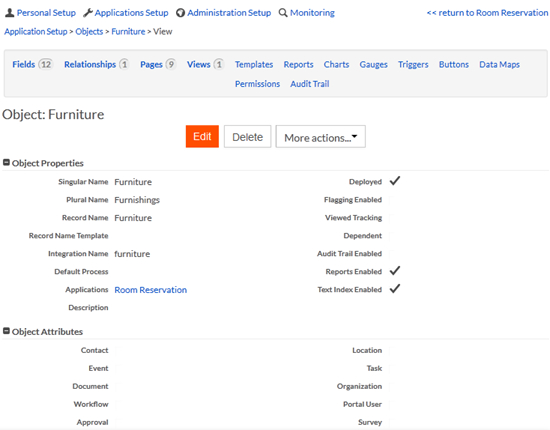Object definition overview
Object definitions are containers for fields. They have attributes and properties that specify how the individual records are structured, how they will behave, and how they can be accessed. Object definitions also contain the following child component definitions: fields, relationships, views, templates, pages, reports, charts, gauges, and triggers.
Object definitions specify read/write permissions per role and per user. They also have a complete administrative audit trail, allowing you to see the who, what, and when of any change that occurred to an object definition, its components, or the associated records. The following screen shows an example object definition for Furniture records. The ribbon of Fields, Relationships, and other components contains links to navigate to the section of the object definition where those child components are defined.

You can create object definitions using the Quick Create wizard, from scratch, by importing from spreadsheets or other applications, or by linking to data stored in other applications. An import usually brings in records, and if those records do not map to existing object definitions, new object definitions can be created as a side effect. Those procedures are described in:
- Getting Started with the Quick Create Wizard
- Creating and Managing Objects, Fields, and Relationships
- Importing to Create a New Object - describes how to create an object from a spreadsheet.
- Linking a Platform Object to OpenEdge
- Using DataDirect Hybrid Data Pipeline to Access External Data
- Creating Platform Applications from Microsoft Access
- Using External Tables as Platform Objects
Object definitions can be shared among applications. Records for a particular object in a tenant will be available in any application that includes that object. When you publish an application, you can choose to add sample records as seed records for the users who will install the application.
Once an object definition exists, in addition to editing and adding fields and properties, you can do the following:
- Clone an object — Create a new object definition with a new name and copy all components, fields, triggers, etc. to the new object.
- Create and run triggers — Select one or more triggers to run on all object records (for data maintenance, etc.) See Trigger overview for more information.
- Define conditional formulas — Create formulas to enable/disable edit and delete functionality for object records.